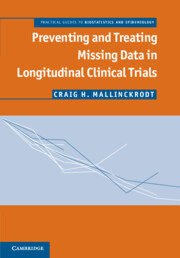Book contents
5 - Trial Conduct Considerations
Published online by Cambridge University Press: 05 February 2013
Summary
Introduction
The previous chapter on design options to lower rates of missing data noted that evidence to support various approaches was limited because studies are not done specifically to assess how trial design influences retention. Therefore, most assessments are on a between-study basis and thus many confounding factors can mask or exaggerate differences due to trial methods. These same factors limit understanding of how trial conduct influences retention. Again, mindful of these limitations, the recent NRC guidance (NRC 2010) provides a number of suggestions on ways to minimize missing data.
Actions for Design and Management Teams
Trial design should limit participants’ burden and inconvenience in data collection. However, once again a trade-off needs to be considered; collecting less data means getting less information. Therefore, study teams need to strike a balance between the conflicting goals of getting the most information possible from a trial and reducing patient burden in order to increase retention (NRC, 2010).
Trial Conduct Options to Reduce Missing Data
Actions for Design and Management Teams
Trial design should limit participants’ burden and inconvenience in data collection. However, once again a trade-off needs to be considered; collecting less data means getting less information. Therefore, study teams need to strike a balance between the conflicting goals of getting the most information possible from a trial and reducing patient burden in order to increase retention (NRC, 2010).
- Type
- Chapter
- Information
- Preventing and Treating Missing Data in Longitudinal Clinical TrialsA Practical Guide, pp. 33 - 36Publisher: Cambridge University PressPrint publication year: 2013



